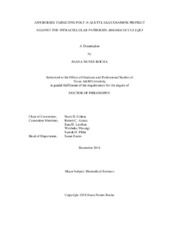| dc.contributor.advisor | Cohen, Noah D | |
| dc.creator | Rocha, Joana Nunes | |
| dc.date.accessioned | 2019-01-23T16:38:23Z | |
| dc.date.available | 2019-01-23T16:38:23Z | |
| dc.date.created | 2018-12 | |
| dc.date.issued | 2018-11-21 | |
| dc.date.submitted | December 2018 | |
| dc.identifier.uri | https://hdl.handle.net/1969.1/174337 | |
| dc.description.abstract | Rhodococcus equi is a facultative intracellular pathogen that causes pyogranulomatous pneumonia in foals <6 months of age. Why foals are highly susceptible to R. equi is unknown. R. equi pneumonia is a leading cause of morbidity and mortality for foals and continues to be an economic burden for the horse industry world-wide. A commercial vaccine against R. equi is lacking. We determined the immunogenicity and efficacy of maternal vaccination with the highly conserved microbial surface polysaccharide, β-1→6-linked poly-N-acetyl glucosamine (PNAG) in foals against intrabronchial infection with R. equi and characterized the functional properties associated with antibodies to R. equi.
We vaccinated 19 pregnant mares 6 and 3 weeks prior to foaling with PNAG and experimentally infected their foals at ~4 weeks of age with ~10^6 cfu of R. equi. Eleven of 12 (92%) foals born to immunized mares remained healthy, whereas 6 of 7 (86%) foals born to unvaccinated controls developed pneumonia (P=0.0017). Antibodies to PNAG mediated killing of extracellular and intracellular R. equi in the presence of complement and neutrophils by PNAG recognition on infected cells. Peripheral blood mononuclear cells from immune and protected foals released higher levels of interferon-γ in response to PNAG compared to controls, indicating vaccination also induced an antibody-dependent cellular release of immune cytokines. To determine the relative function in immunity to R. equi, sub-isotypes IgGv1 and IgGv4/7 were enriched using a protein G column from PNAG hyperimmune or nonimmune plasmas. They were compared in their ability to deposit complement component 1 (C1) on to PNAG and to mediate opsonophagocytic killing
(OPK) by neutrophils. Sub-isotype IgGv1 from PNAG hyperimmune plasma had the highest ability to deposit C1 onto PNAG (P<0.05) and to elicit OPK by neutrophils (P<0.05). These results show maternal vaccination with PNAG generates antibodies that are transferred via colostrum that protect foals against the intracellular pathogen, R. equi by facilitating antibody-mediated opsonic killing, and that sub-isotype IgGv1 targeting PNAG appears to be a correlate of protective immunity. Additionally, vaccination appeared to modulate interferon-γ release in response to PNAG on R. equi, suggesting that PNAG antibodies derived from colostrum might mediate cell immunity. | en |
| dc.format.mimetype | application/pdf | |
| dc.language.iso | en | |
| dc.subject | Rhodococcus equi | en |
| dc.subject | PNAG | en |
| dc.subject | Vaccine | en |
| dc.subject | IgG subisotypes | en |
| dc.subject | functional mechanisms | en |
| dc.title | Antibodies Targeting Poly-N-Acetyl Glucosamine Protect Against the Intracellular Pathogen, Rhodococcus Equi | en |
| dc.type | Thesis | en |
| thesis.degree.department | Veterinary Large Animal Clinical Sciences | en |
| thesis.degree.discipline | Biomedical Sciences | en |
| thesis.degree.grantor | Texas A & M University | en |
| thesis.degree.name | Doctor of Philosophy | en |
| thesis.degree.level | Doctoral | en |
| dc.contributor.committeeMember | Alaniz, Robert C | |
| dc.contributor.committeeMember | Lawhon, Sara D | |
| dc.contributor.committeeMember | Mwangi, Waithaka | |
| dc.contributor.committeeMember | Pillai, Suresh D | |
| dc.type.material | text | en |
| dc.date.updated | 2019-01-23T16:38:23Z | |
| local.etdauthor.orcid | 0000-0001-6130-9560 | |


